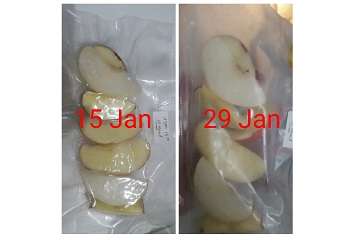IPB Student Utilizes Sago Starch to Maintain the Freshness Cut Fruits

With its vast and abundant fertile soils Indonesia is a major global key producer of a wide variety of agricultural tropical products, and although agriculture's share of the country's gross domestic product (GDP) has declined markedly during the last five decades, it still provides income for the majority of Indonesian households today. In 2012 this sector employed around 49 million Indonesian individuals, which represents 41 percent of the total Indonesian labour force. In 2013, the agricultural sector contributed to 14.43 percent of national GDP, a slight decline compared to a decade earlier (2003) which reached 15.19 percent. But not all these abundance commodities reach the hands of consumers well, especially climacteric fruits and vegetables that will continue to experience respiration and ethylene formation or they will lose water quickly and become wilted and soft. Fresh produce is at peak quality when picked; its quality can only be maintained (or deteriorated) as it is handled and stored. Maintaining crop quality after harvest is an important consideration for any fresh market produce grower or handler.
Therefore, efforts should be made to inhibit the process of wilting on fresh commodities. The effort can be done with a film coating, a thin layer that wraps a food material that serves to improve the quality of a product, prolong the shelf life, and inhibit water movement. The increased consumer demand for high quality, extended shelf life, ready to eat foods has initiated the development of several innovative techniques to keep their natural and fresh appearance as long as possible and at the same time render them safe. Packaging has been an important element in these preservation concepts for providing the appropriate (mechanical and functional) protection to the commodity.
The supporting material in the manufacture of film coatings is polysaccharides of starch, because in addition to cheap and safe to eat, starch also has a low oxygen permeability and water vapour properties. Sago starch is one type of starch that is abundant in Indonesia, unfortunately a large sago forest is not fully utilized. Biodegradable polymers based on natural polysaccharides, particularly starch, are used to develop biodegradable films because they have the capability of forming a continuous matrix and they are a renewable and abundant resource so it is potentially made coating film. However, the results reveal that sago starch films generally have low solubility in water. It was also found that higher glycerol content leads to decreased tensile strength and increased elongation of the films, while constant glycerol content with higher amylose content results in increased tensile strength and decreased elongation of the films.
Departing from the problem, Dyah Ayu Larasati, Student of the Department of Agroindustrial Technology, of the Faculty of Agricultural Technology, of Bogor Agricultural University (FATETA IPB) tried to modify natural sago starch to produce better film coating by mixing it with citric acid, (filler), and glycerol.
Female student who familiarly called Ayu, carried out her research program on "Sifat Fisik Mekanik Coating Film Berbasis Pati Sagu (Metroxylon sp.) Ikat Silang Asam Sitrat (Physical Properties of Coating-Based Film of Starch Sago (Metroxylon sp.) Based on Citric Acid Crosslinking Modification) under the supervision of Dr. Indah Yuliasih and Dr. Titi Candra Sunarti
The selection of citric acid can cross-link starch and improve the tensile strength, thermal stability and decrease the dissolution of starch films in water and formic acid. The poor mechanical properties and water stability of starch have restricted its industrial applications. Although cross-linking is a common approach to improve the properties of starch products, current starch cross-linking methods are either expensive, toxic or do not impart the desired properties to the cross-linked materials.
"Well to produce coating film with a compact structure, Ayu provided additional fillers (filler) derived from polysaccharides, namely CMC (carboxymethyl cellulose) and chitosan. Besides, the addition of glycerol as a plasticizer will improve the nature of the film coatings based on sago cross-linked starch to further improve the physical properties of mechanics," she said.
Based on the findings, Ayu concluded that citrate starch with 2.5% concentration, and 5-10% CMC addition, 50-100% chitosan, and 80% glycerol concentration were able to form film with good mechanical strength.
Remarkably, the film which is kept at 40°C has increased its tensile strength and elongation up to the sixth week. Furthermore, Ayu said that the resulting citrate starch has been applied to the peeled apples and can last up to 2 weeks with no browning happening. Currently starch citric invented by Ayu, has already been produced as requested by a private company.
"All research that started in the laboratory should not just stop in the laboratory alone. Must be able to solve existing problems in the field Community-based research must have a high degree of relevance to the community. Community-based research focuses the research endeavour in the context of daily work activities in order to solve problems and help make those activities more effective and ultimately more satisfying," pleaded Ayu. "For example, the film coating has always been imported, but the one I produce as resulted of our research, the quality is not much different, but it much cheaper,” she said. (Wied)



